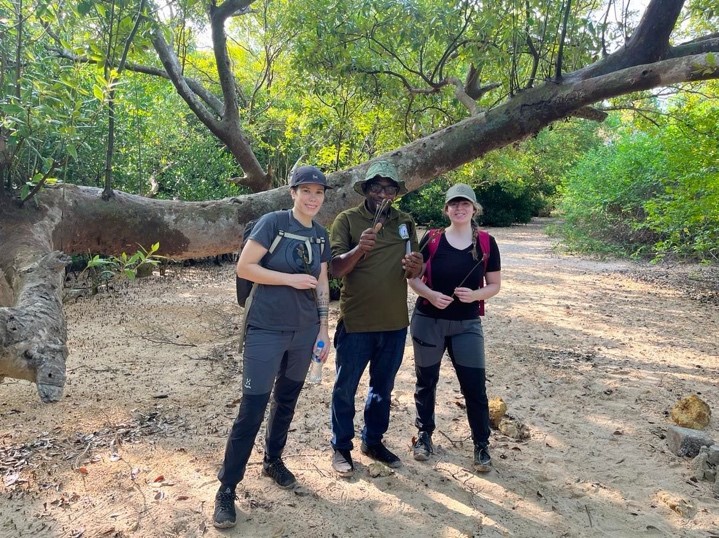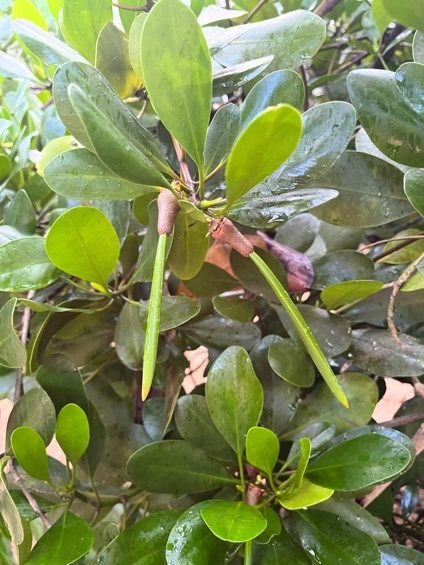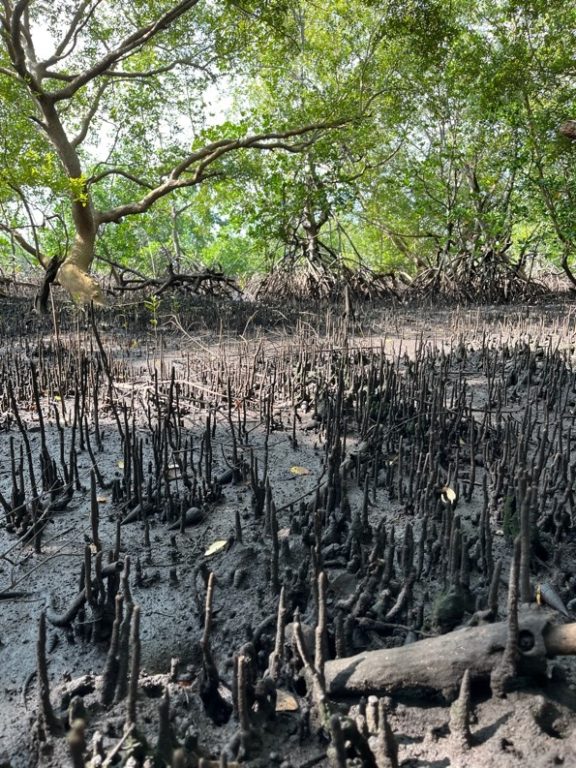This blog post is written by Josefine Norgren and Johanna Pettersson, students at the MSc course “Sustainable Forestry and Land Use Management in the Tropics” during a field trip to Tanzania December 2022.

The mangroves in Tanga district, Tanzania. From left: Josefine Norgren, Yusuph Kajia and Johanna Pettersson. Photo: Ulrik Ilstedt.
During a field trip to Tanzania with SLU we got the chance to visit a mangrove forest located in the coastal district of Tanga. We had the privilege to learn from a local guide, Yusuph Kajia, who is working for the Tanzania Forest Service Agency.
We discovered that despite mangrove forests having many important functions, they have not received the same attention as other forest ecosystems on the planet. Yet, they are one of the world’s most important ecosystems! You have probably heard about climate change and the importance of reducing CO2 emissions. You may also have heard how trees and forests can mitigate climate change and their potential to sustain livelihoods for millions of people. But have you heard specifically how the mangrove ecosystem is connected to these topics? And why should we even care about an ecosystem that makes up only 0.1% of the Earth’s surface? We want to tell you why!
Why are mangrove forests important?
The mangrove forest ecosystem is a unique and vital part of the Earth’s natural landscape, providing a wide range of ecological, economic, and social benefits to both local and global communities. These forests are found in tropical and subtropical regions worldwide and are characterized by their ability to thrive in salty, coastal environments. Mangrove species have one of the most unique reproductive strategies in the plant world. Some mangrove species are viviparous, which means that seeds germinate into seedlings while still attached to the parent plant[1]. Our guide Yusuph explained another unique strategy, so called aerial roots, that some of the mangrove species have developed in order to survive in this aquatic environment.

Viviparous seeds on a parent plant. These seeds will eventually fall to the ground and take root. Photo: Josefine Norgren
Tanzania has ten different species of mangroves that have many important functions. Apart from acting like a carbon sink, they also provide shelter for a vast number of plant, animal and aquatic species, holding great biodiversity[2]. Yusuph explained that the mangroves also serve as natural barriers against storms and erosion, protecting inland areas from flooding and other natural disasters. He also mentioned that these forests support the livelihoods of local communities who rely on them for a range of activities, such as fishing and wood harvesting, which provide food, shelter, and income for millions of people.

Aerial roots (at the bottom of the picture). Photo: Josefine Norgren
Why should we care about saving the mangroves?
Historically, mangroves have been extensively logged, leading to a decline in their extent and quality. Today, they still face many challenges and threats mainly caused by human activities, such as land conversion, pollution from industrial and agricultural activities, and the impacts of climate change, according to Yusuph. This is a concern considering its many important functions mentioned earlier. Another important factor that can incentivize safeguarding of mangrove ecosystems is that they can capture and store carbon at a much higher rate than most terrestrial forests. When carbon is captured by the world´s oceans and coastal ecosystems, it’s called Blue carbon. Most of this carbon is stored below ground in the soil and is often thousands of years old[3]. Coastal mangroves are also estimated to store up to four times more carbon compared to temperate and boreal forests![4] This makes them an essential tool in the fight against climate change.
Overall, mangrove forests are a vital and complex ecosystem that provides a range of important ecosystem services. Losses of mangroves can have a huge impact on the climate, biodiversity and people’s livelihoods, which should be a strong incitement to care about the conservation and restoration of this forest ecosystem.
What is done today?
The tide has turned and things are changing for the better. The loss of mangroves is declining and our knowledge of their value and importance has improved[4]. In recent years, there has been a renewed focus on sustainable management of these ecosystems to ensure that mangrove forests are protected and managed in a responsible manner, according to Yusuph. This includes the development of new management plans, the implementation of conservation measures, and the enforcement of forestry regulations. Yusuph explains that they also work with local communities and other stakeholders to ensure that the benefits of mangrove forests are shared equitably and sustainably. They are, for example, establishing plantation forests aimed to fuel wood harvesting to relieve the pressure on the mangroves.
“Government cannot protect the forest alone, we need to include the locals to save the mangroves” – Yusuph
Another example is an area of 69.3 ha of mangroves in the Tanga District in Tanzania that was rehabilitated successfully between 1994 and 2003 as part of a collaborative coastal management approach involving local communities[5].
The most recent effort connected to the issue of mangrove deforestation was a report launched in September 2022 by The Global Mangrove Alliance (GMA). The GMA consists of over 30 organizations that work together to accelerate mangrove restoration and conservation measures around the globe. The report is given out annually and aims to compile the most current information on what we know about the mangrove forests and what is being done to reverse the downward trend. Nowadays, we also have access to more extensive and reliable data about the current status of the mangroves via the Global Mangrove Watch maps.
We have learned that the mangroves support many important functions that are crucial for humanity and that this ecosystem can play a key role in mitigating climate change. To stop the loss of mangrove forests across the globe, it is essential that we work together to identify and address the root causes of habitat loss and degradation. This may involve working with local communities to promote sustainable land use practices, supporting conservation efforts, and investing in research and monitoring to better understand the dynamics of these complex ecosystems. By taking a proactive approach, we can ensure that these valuable ecosystems continue to thrive and provide a range of benefits for future generations.
[1] Reproductive Strategies of Mangroves. https://www.nhmi.org/mangroves/rep.htm [2023-01-10]
[2] Tanzania Forest Service Agency (TFS). Tanzania’s Mangroves. https://www.tfs.go.tz/index.php/en/forests/tanzanias-mangroves [2023-01-10]
[3] National Oceanic and Atmospheric Administration. What is Blue Carbon? https://oceanservice.noaa.gov/facts/bluecarbon.html [2023-01-10]
[4] Leal, M. & Spalding, M. (2022). The State of the World’s Mangroves 2022. Global Mangrove Alliance.
[5] Erftemeijer, P., de Boer, M., Hilarides, L. (2022). Status of Mangroves in the Western Indian Ocean Region. Wetlands International.
